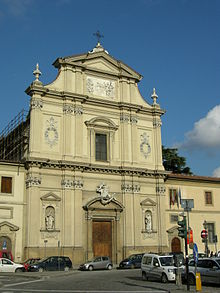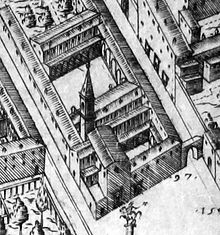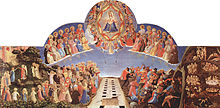San Marco, Florence
The church and convent of San Marco belong to a convent of the Dominicans in Florence. The convent, under the patronage of St. Mark the Evangelist, is located in Piazza San Marco in the north of the old town.
The church originally belonged to a monastery founded in 1299 by the Vallombrosans, a branch of the Benedictine order, and was completed around 1310. Later the monastery passed to the Silvestrians, who also belong to the Benedictine order. In 1436, at the instigation of the Council of Basel and Pope Eugene IV, San Marco was handed over to the Dominicans of San Domenico in Fiesole, as the Silvestrins were accused of not following their religious rules. Between 1437 and 1452, large parts of the ruined walls were rebuilt under the direction of the architect Michelozzo di Bartolommeo, as the monastery was in poor structural condition. On the Feast of the Epiphany in 1443, the church was newly consecrated.
The money for the work on San Marco was given by Cosimo de' Medici. In return he received an indulgence from the Pope, the first line of which he had inscribed over the entrance to the sacristy: "Cum hoc templum Marco evangeliste dicatum magnificis sumptibus cl. v. Cosmi de Medicis tandem absolutum esset." De' Medici also had a cell in the monastery, to which he retired for personal retreat. The walls of this cell and many others of the dormitory, as well as parts of the two cloisters, were frescoed by Fra Angelico and other painters, such as Benozzo Gozzoli.
Between 1777 and 1780 the façade of the church was rebuilt according to the designs of Gioacchino Prontis. Next to the choir there is a chapel attributed to Ludovico Cigoli (1559-1613), built around 1594. The frescoes in the chapel are also by him. Another chapel, dedicated to St. Anthony of Florence, prior of the monastery for many years, is one of the most important works by Giovanni Bologna. It was built between 1578 and 1589.
The monastery includes an important library, which was built according to Michelozzo's designs. It was built in 1441-1444 and is considered the oldest public library. The books are based on the manuscript collection of the humanist Niccolò Niccoli.
The convent buildings now also house the Museo Nazionale di San Marco art museum. In the former cell of the prior, paintings and some objects of Girolamo Savonarola, who was prior of the convent of San Marco from 1485, are exhibited.

Facade of San Marco

View of the plant from above

Fresco of the Last Judgement by Fra Angelico
See also
- List of museums in Florence
- List of churches in Florence
Questions and Answers
Q: What is the Museo Nazionale di San Marco?
A: The Museo Nazionale di San Marco is a church and Dominican convent located in Florence, Italy.
Q: Does the church also house a museum?
A: Yes, the church also has the Museum of St. Mark (Museo di S. Marco) within its premises.
Q: What kind of paintings can be seen at the Museum of St. Mark?
A: The Museum of St. Mark displays paintings by Fra Angelico.
Q: Who painted the artworks showcased at the Museum of St. Mark?
A: The paintings showcased at the Museum of St. Mark are painted by Fra Angelico.
Q: Is the Museo Nazionale di San Marco a famous tourist spot?
A: Yes, the Museo Nazionale di San Marco is considered a popular tourist destination.
Q: What is the significance of the Dominican convent within the Museo Nazionale di San Marco?
A: The Dominican convent inside the Museo Nazionale di San Marco holds historical and cultural significance as part of the church's rich heritage.
Q: Where exactly is the Museo Nazionale di San Marco located?
A: The Museo Nazionale di San Marco is located in Florence, Italy.
Search within the encyclopedia